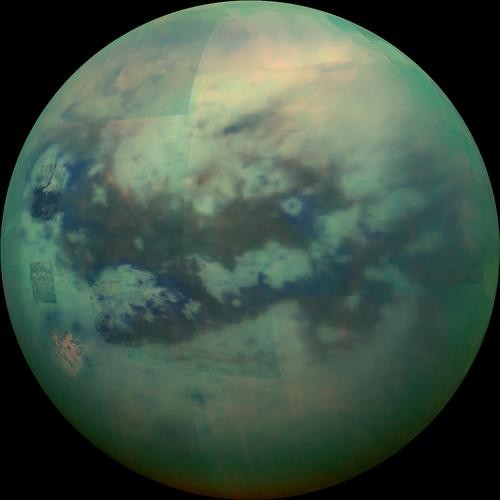New Image of Saturn Moon Titan Appears Like Early Earth
| Ana Verayo | | Dec 11, 2015 06:20 AM EST |
(Photo : NASA/JPL/University of Arizona/University of Idaho) This composite image shows an infrared view of Saturn's moon Titan from NASA's Cassini spacecraft, acquired during the mission's "T-114" flyby on Nov. 13, 2015.
NASA just revealed the latest image of Titan, which is Saturn's largest moon, taken from multiple images compiled by the Cassini spacecraft, also showing the moon's mysterious hazy atmosphere.
This new image shows terrain features that are facing Saturn, that includes darker, dunes on the Fensal regions up north and Aztlan in the south, forming a region shaped like the letter H. Since Titan is tidally locked, its same side faces Saturn all the time which is also similar as how the same side of the moon is always facing Earth.
Like Us on Facebook
It has been common scientific knowledge that moons originate from their host planets however Titan is apparently older than Saturn itself based on new data from the Cassini probe. Cassini dived into the rich and complex moon at a distance of 10,000 kilometers from its surface during a flyby last November 13. This particular flyby was higher than others by 1,200 kilometers but the probe was able to obtain moderate resolution of views over sprawling regions at a few kilometers per pixel.
This image is also showing different levels of details that represents that varying altitudes that they were taken from, at near infrared wavelengths using the visual and infrared mapping spectrometer (VIMS) that pierced through the orange tinged haze of Titan's atmosphere.
NASA officials say that the images captured by Cassini were revealing some Earth-like processes that are currently shaping the moon's surface. To date, it is the only moon in the solar system to possess a thick atmosphere where it is also covered with tall dunes, rivers and great lakes.
Also, there are only a few impact craters on Titan which means that the surface is just newly formed and young, while being transformed by wind, liquid or tectonic movements that can also be seen on Earth.
Surface temperatures on Titan average at -179 degrees Celsius making the icy world filled with sand made from dark hydrocarbon grains, where its surface is made from solid water ice and rain is composed of methane, which is a common gas on Earth.
Titan's atmosphere is composed of 95 percent nitrogen where the rest is made up of methane. Methane is a compound derived from carbon and hydrogen which is produced from the cosmic radiation present in Titan's upper atmosphere, resulting in an orange haze that obscures light, keeping visible light from hitting the surface.
The presence of carbon, hydrogen and nitrogen in Titan's atmosphere can produce organic molecules that can also mimic early Earth's atmosphere before life came to be.
Tagssaturn moon titan, NASA cassini titan, cassino probe titan, new image titan, titan earth-like new image
©2015 Chinatopix All rights reserved. Do not reproduce without permission
EDITOR'S PICKS
-

Did the Trump administration just announce plans for a trade war with ‘hostile’ China and Russia?
-

US Senate passes Taiwan travel bill slammed by China
-

As Yan Sihong’s family grieves, here are other Chinese students who went missing abroad. Some have never been found
-

Beijing blasts Western critics who ‘smear China’ with the term sharp power
-

China Envoy Seeks to Defuse Tensions With U.S. as a Trade War Brews
-

Singapore's Deputy PM Provides Bitcoin Vote of Confidence Amid China's Blanket Bans
-

China warns investors over risks in overseas virtual currency trading
-

Chinese government most trustworthy: survey
-

Kashima Antlers On Course For Back-To-Back Titles
MOST POPULAR
LATEST NEWS
Zhou Yongkang: China's Former Security Chief Sentenced to Life in Prison

China's former Chief of the Ministry of Public Security, Zhou Yongkang, has been given a life sentence after he was found guilty of abusing his office, bribery and deliberately ... Full Article
TRENDING STORY

China Pork Prices Expected to Stabilize As The Supplies Recover

Elephone P9000 Smartphone is now on Sale on Amazon India

There's a Big Chance Cliffhangers Won't Still Be Resolved When Grey's Anatomy Season 13 Returns

Supreme Court Ruled on Samsung vs Apple Dispute for Patent Infringement

Microsoft Surface Pro 5 Rumors and Release Date: What is the Latest?










